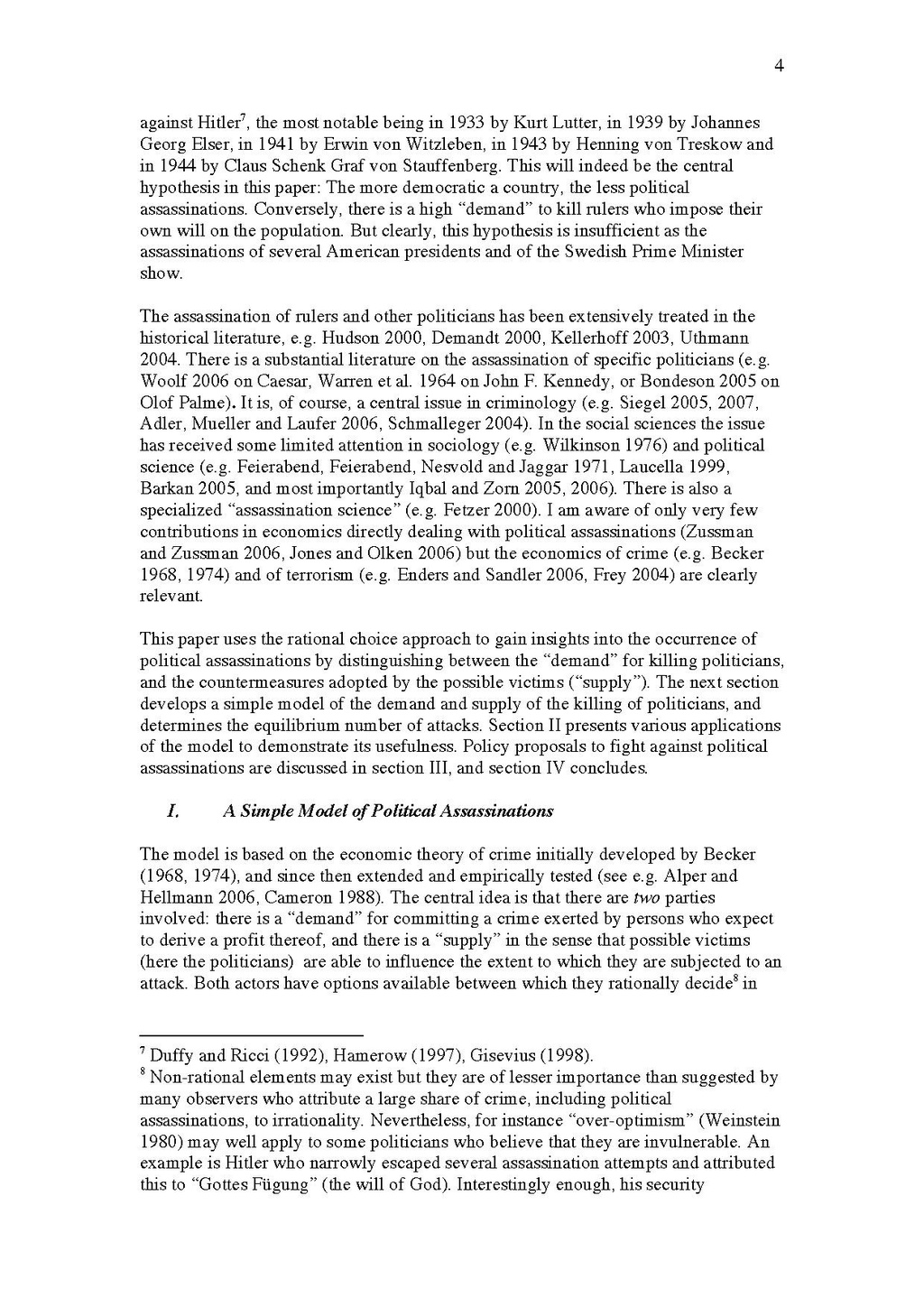against Hitler”, the most notable being in 1933 by Kurt Lutter, in 1939 by Johannes Georg Elser, in 1941 by Erwin von Witzleben, in 1943 by Henning von Treskow and in 1944 by Claus Schenk Graf von Stauffenberg. This will indeed be the central hypothesis in this paper: The more democratic a country, the less political assassinations. Conversely, there is a high “demand” to kill rulers who impose their own will on the population. But clearly, this hypothesis is insufficient as the assassinations of several American presidents and of the Swedish Prime Minister show.
The assassination of rulers and other politicians has been extensively treated in the historical literature, e.g. Hudson 2000, Demandt 2000, Kellerhoff 2003, Uthmann 2004. There is a substantial literature on the assassination of specific politicians (e.g. Woolf 2006 on Caesar, Warren et al. 1964 on John F. Kennedy, or Bondeson 2005 on Olof Palme). It is, of course, a central issue in criminology (e.g. Siegel 2005, 2007, Adler, Mueller and Laufer 2006, Schmalleger 2004). In the social sciences the issue has received some limited attention in sociology (e.g. Wilkinson 1976) and political science (e.g. Feierabend, Feierabend, Nesvold and Jaggar 1971, Laucella 1999, Barkan 2005, and most importantly Iqbal and Zorn 2005, 2006). There is also a specialized “assassination science” (e.g. Fetzer 2000). I am aware of only very few contributions in economics directly dealing with political assassinations (Zussman and Zussman 2006, Jones and Olken 2006) but the economics of crime (e.g. Becker 1968, 1974) and of terrorism (e.g. Enders and Sandler 2006, Frey 2004) are clearly relevant.
This paper uses the rational choice approach to gain insights into the occurrence of political assassinations by distinguishing between the “demand” for killing politicians, and the countermeasures adopted by the possible victims (“supply”). The next section develops a simple model of the demand and supply of the killing of politicians, and determines the equilibrium number of attacks. Section II presents various applications of the model to demonstrate its usefulness. Policy proposals to fight against political assassinations are discussed in section III, and section IV concludes.
1.
A Simple Model of Political Assassinations
The model is based on the economic theory of crime initially developed by Becker (1968, 1974), and since then extended and empirically tested (see e.g. Alper and Hellmann 2006, Cameron 1988). The central idea is that there are two parties involved: there is a “demand” for committing a crime exerted by persons who expect to derive a profit thereof, and there is a “supply” in the sense that possible victims (here the politicians) are able to influence the extent to which they are subjected to an attack. Both actors have options available between which they rationally decide$ in
7
8
Duffy and Ricci (1992), Hamerow (1997), Gisevius (1998). Non-rational elements may exist but they are of lesser importance than suggested by many observers who attribute a large share of crime, including political assassinations, to irrationality. Nevertheless, for instance “over-optimism” (Weinstein 1980) may well apply to some politicians who believe that they are invulnerable. An example is Hitler who narrowly escaped several assassination attempts and attributed this to “Gottes Fügung” (the will of God). Interestingly enough, his security
